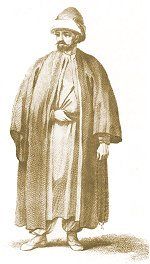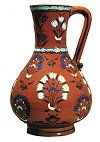Serving the Guest: A Sufi Cookbook
Essays | Recipes | Gallery

In all Rufai dergahs there are dining rooms seating two to two hundred fifty people. Long floor tables are set, and everyone gathers around them sitting on the floor. In each area with ten to twelve persons, a large pot of food is set in the middle. These pots are set continuously along the tables.
The Shaikh's place is set at the head of the table. The Shaikh begins by reciting the Gulbeng, a prayer that belongs to Ehli Beyt, the Prophet's immediate family; then continues with a dua. The Shaikh then takes the first bite, followed by everyone there. The time of eating is passed in silence.
Lentil soup is always the first course of dinner. Our prophet Hazrati Muhammad (peace and blessings upon him) and Hazrati Ali (may Allah be pleased with him) had lentils in their daily diet. They are very healthy for our well-being. This custom continues to be kept in the dergahs and in the gatherings of dervishes. The second course is usually meat and vegetables. This meat is usually the kurban (sacrificial) lamb, prepared according to a special technique. A very large pot of wheat is brought to a boil, then small pieces of lamb are added and mixed continuously for twelve hours. In this process, the wheat and the lamb dissolve into each other and take the form of a paste. The name of this dish is Keshkek. While it is being prepared, Surah Isra from the Qur'an is recited, then Surah 33 Ayat 33, followed by Surah Fatiha and eleven recitations of Surah Ikhlas. All of the above is sent to the soul of our Prophet and to the souls of our Pirs, Pir Ahmed El Rufai and Pir Muhammad Gethel Marufi Rufai (may Allah be pleased with them). The third and last course of dinner is pilaf. After dinner desserts are served, such as baklava, qadayif or halvah. When all are done eating, the Shaikh and his khalifa (assistant) recite again the Gulbeng and a dua. Dervishes are then assigned to clear the tables so that tea may be served. Tea in the dergah is boiled in large samovars. A small tea pot is filled with loose tea leaves, then hot water from the samovar is poured into the pot and sits for twenty minutes to brew and take its color.

In the month of Ramadan, olives and dates are eaten to break the fast before dinner is served. After dinner a special dessert is served. Called gulac, it is prepared with fine fillo dough filled with walnuts, almonds and chestnuts, then rolled in finger shape and boiled with milk. When Ramadan falls in the summer, ayran is served after the Terawih prayers.
The month of Muharram, the Islamic New Year, is also a very special time in the dergahs. Pumpkin sweets are made. On the tenth of Muharram, the day of the martyrdom of Huseyn at Kerbala, a dish called ashura is prepared with twelve different ingredients boiling in one large pot — fava beans, chick peas, wheat, apricot, raisin, walnuts, hazelnuts, and more, with pomegranate sprinkled on top. Prayers are recited as in all preparation of food, including a mersiye for Kerbala. Like a kaside, it is a salawat given to Ehli Beyt for Kerbala. The dervishes recite the dua of Kerbala while eating ashura in the dergah; the Imam Huseyn and the martyrs of Kerbala are remembered, then the Gulbeng is recited again.
from Serving the Guest: A Sufi Cookbook
Copyright © 1999, 2000 by Kathleen Seidel
Sources of previously published material by other authors used by permission, and print sources for images, may be found at http://www.superluminal.com/cookbook.